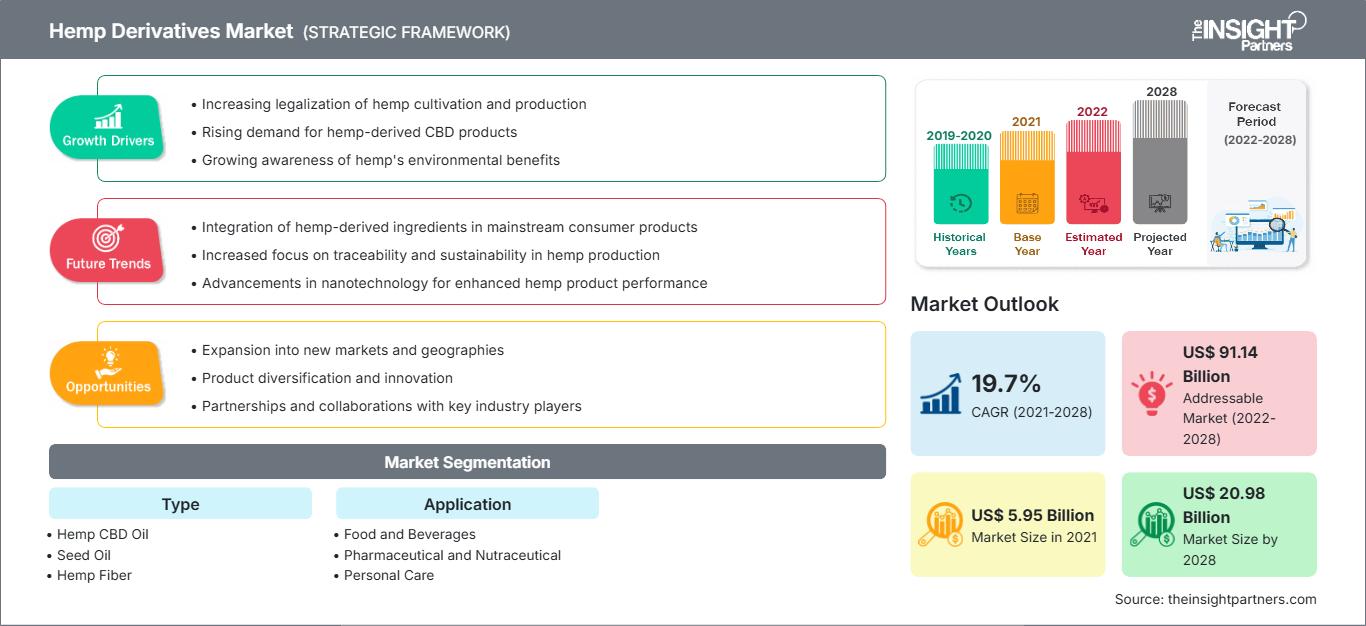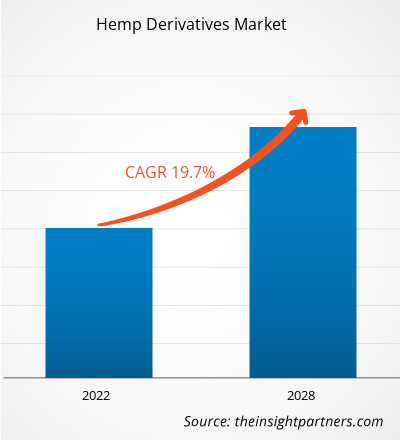Der Markt für Hanfderivate wurde im Jahr 2021 auf 5.953,86 Millionen US-Dollar geschätzt und soll bis 2028 20.977,94 Millionen US-Dollar erreichen; von 2021 bis 2028 wird ein durchschnittliches jährliches Wachstum von 19,7 % erwartet.
Hanf oder Industriehanf ist eine Pflanzenart der Gattung Cannabis sativa, die speziell für die industrielle Nutzung angebaut wird. Hanfderivate wie CBD, Samenöl und Fasern werden aus Hanf gewonnen und finden vielfältige Anwendung in verschiedenen Endverbrauchsbranchen wie der Lebensmittel- und Getränkeindustrie, der Pharmaindustrie, der Körperpflege und der Tierfutterindustrie.
Im Jahr 2021 hatte der asiatisch-pazifische Raum den größten Anteil am weltweiten Markt für Hanfderivate. Das steigende Bewusstsein für den medizinischen Nutzen von Hanfderivaten erhöht deren Nutzung in der Region. Darüber hinaus finden Hanfderivate vielfältige Anwendung in der Textilindustrie. Darüber hinaus wird erwartet, dass der boomende Markt für Kosmetik- und Körperpflegeprodukte im asiatisch-pazifischen Raum sowie die Legalisierung von Industriehanf in Nahrungsergänzungsmitteln den Markt in der Region im Prognosezeitraum ankurbeln werden.
Die anhaltende COVID-19-Pandemie hat sich relativ positiv auf den Markt für Hanfderivate ausgewirkt. Sie hat dazu beigetragen, das Bewusstsein und das Interesse für den medizinischen Hanfsektor zu stärken. Die Krise war für den Großteil der Weltbevölkerung eine unangenehme und stressige Zeit. Daher haben Menschen weltweit begonnen, Hanfderivate zur Behandlung von Angstzuständen und Stress zu konsumieren. Einige bedeutende Konsumenten haben ihren Konsum erhöht. Auch die Annahme, dass Hanfprodukte zur Behandlung von Schlafstörungen und Depressionen eingesetzt werden, ist übertrieben. Aufgrund des verstärkten Fokus auf Gesundheit und Wellness während der Pandemie wurde bei Google vermehrt nach den gesundheitlichen Vorteilen von Hanfderivaten gesucht, was das Bewusstsein für diese Derivate schärft. Darüber hinaus litten viele Länder während der Pandemie unter Steuerausfällen. Die Regierungen der Länder suchen nach Steuereinnahmen. Eine potenzielle Quelle könnte die Legalisierung von Hanf und seinen Derivaten sein, die zunehmend an Bedeutung gewinnen könnte. Ein Anstieg des Verkaufs von Hanf und seinen Derivaten durch legale Verkäufer kann potenzielle Steuereinnahmen bringen.
Während der COVID-19-Pandemie wurden zudem verschiedene Forschungsaktivitäten durchgeführt, die sich auf die Verwendung von Hanf und seinen Derivaten zur Behandlung von COVID-19 konzentrierten. Forscher in Kanada führten eine Studie durch, um sicherzustellen, dass Cannabis-Sativa-Extrakte dazu beitragen können, die Konzentration des Wirtszellrezeptors zu senken, an den sich das SARS-CoV-2-Virus heftet, um einzudringen und sich zu verbreiten. Darüber hinaus bietet STERO Biotech, ein Unternehmen mit Hauptsitz in Israel, Einblicke in die Verwendung von Cannabis und CBD als potenzielle Behandlung von COVID-19. Somit wirken sich verschiedene Forschungsaktivitäten zu Hanf und seinen Derivaten, um deren Einsatz in der COVID-19-Behandlung zu erforschen, positiv auf den Markt für Hanfderivate aus.
Passen Sie diesen Bericht Ihren Anforderungen an
Sie erhalten kostenlos Anpassungen an jedem Bericht, einschließlich Teilen dieses Berichts oder einer Analyse auf Länderebene, eines Excel-Datenpakets sowie tolle Angebote und Rabatte für Start-ups und Universitäten.
Markt für Hanfderivate: Strategische Einblicke

-
Holen Sie sich die wichtigsten Markttrends aus diesem Bericht.Dieses KOSTENLOSE Beispiel umfasst Datenanalysen, die von Markttrends bis hin zu Schätzungen und Prognosen reichen.
Hanf wird zunehmend für verschiedene Anwendungen in unterschiedlichen Branchen eingesetzt. Hanfsamen und Ölkuchen dienen als alternative Quelle für Nahrungs- und Futterproteine in der Lebensmittel- und Getränkeindustrie. Das durch Zerkleinern der Hanfsamen gewonnene Öl wird zur Herstellung von Seife, Shampoo, Lotion, Kosmetika und Badegelen verwendet. Das aus Hanfsamen gewonnene Öl ist reich an Aminosäuren, Mineralien und Vitaminen und wird in Nahrungsergänzungsmitteln sowie medizinischen und therapeutischen Produkten verwendet. Die aus Hanf gewonnenen Fasern enthalten einen hohen Anteil an Hemicellulose und verfügen über eine hohe Saugfähigkeit, was sie zu einer geeigneten Nutzpflanze für die Textilindustrie macht. Hanfstängel und -fasern werden unter anderem zur Herstellung von Kleidung, Papier, Baumaterialien, Kunststoffen und Verbundwerkstoffen verwendet. Hanffasern werden aufgrund ihrer hohen Festigkeit, biologischen Abbaubarkeit, thermodynamischen Eigenschaften und ihres geringen Gewichts auch zur Herstellung von Dämmstoffen und Biokompositen eingesetzt. Hanffasern werden in der Bauindustrie zur Herstellung von Baumaterialien wie Faserplatten, Stuck und Mörtel, Zementblöcken, Beschichtungen, Akustikmaterialien und Rohrummantelungen verwendet. Auch Verbundwerkstoffe, die bei der Herstellung von Produkten auf Erdölbasis zum Einsatz kommen, werden aus Hanf hergestellt. Die Hanfsamen sind reich an Nährstoffen und Proteinen und können als Ersatz für Sojabohnen verwendet werden. Aufgrund ihres Proteingehalts werden Hanfsamen bei der Herstellung wichtiger Produkte aus Sojabohnen verwendet, darunter Tofu, Butter, Käse, Burger, Eiscreme und Milch. Die zunehmende Verwendung von Hanfderivaten in verschiedenen Branchen hat somit zu einer steigenden Nachfrage nach Hanfderivaten geführt und damit den Markt für Hanfderivate vorangetrieben.
Typ-Einblicke
Basierend auf dem Typ ist der Markt für Hanfderivate in Hanf-CBD-Öl, Samenöl, Hanffasern und andere segmentiert. Das Segment Hanffasern hatte 2021 den größten Marktanteil. Hanf ist eine Bastfaserpflanze wie Jute, Kenaf und Flachs. Diese Fasern werden heute aufgrund ihrer biologischen Abbaubarkeit und geringeren Dichte als Kunstfasern als Verstärkungen in Verbundwerkstoffen verwendet. Hanffasern leiten Wärme, sind schimmelresistent, lassen sich gut färben, blockieren UV-Licht und haben natürliche antibakterielle Eigenschaften.
Einige der wichtigsten Marktteilnehmer auf dem Markt für Hanfderivate sind Colorado Hemp Works, Inc., Dun Agro Hemp Group, Ecofiber, Hempflax Group BV, Hempoland Sp. Z OO, Konoplex, Mh Medical Hemp Gmbh, Plains Industrial Hemp Processing Ltd., South Hemp und BAFA Neu GmbH. Wichtige Marktteilnehmer verfolgen Strategien wie Fusionen und Übernahmen sowie Produkteinführungen, um ihre geografische Präsenz und Kundenbasis zu erweitern.
Berichts-Spotlights
- Progressive Trends in der Hanfderivatebranche, um Akteuren bei der Entwicklung effektiver langfristiger Strategien zu helfen
- Geschäftswachstumsstrategien, die von Unternehmen übernommen werden, um Wachstum in entwickelten und sich entwickelnden Märkten zu sichern
- Quantitative Analyse des globalen Marktes für Hanfderivate von 2019 bis 2028
- Schätzung der Nachfrage nach Hanfderivaten in verschiedenen Branchen
- Porter-Analyse, um die Wirksamkeit von Käufern und Lieferanten, die in der Branche tätig sind, zur Vorhersage des Marktwachstums zu veranschaulichen
- Jüngste Entwicklungen, um das Wettbewerbsszenario des Marktes und die Nachfrage nach Hanfderivaten zu verstehen
- Markttrends und -aussichten in Verbindung mit Faktoren, die das Wachstum des Marktes für Hanfderivate vorantreiben und hemmen
- Verständnis der Strategien, die das kommerzielle Interesse im Hinblick auf das Wachstum des globalen Marktes für Hanfderivate untermauern, als Unterstützung des Entscheidungsprozesses
- Marktgröße für Hanfderivate an verschiedenen Marktknotenpunkten
- Detaillierte Übersicht und Segmentierung des globalen Hanfs Derivatemarkt sowie seine Branchendynamik
- Größe des Hanfderivatemarktes in verschiedenen Regionen mit vielversprechenden Wachstumschancen
Markt für Hanfderivate
Die Analysten von The Insight Partners haben die regionalen Trends und Faktoren, die den Markt für Hanfderivate im Prognosezeitraum beeinflussen, ausführlich erläutert. In diesem Abschnitt werden auch die Marktsegmente und die geografische Lage in Nordamerika, Europa, im asiatisch-pazifischen Raum, im Nahen Osten und Afrika sowie in Süd- und Mittelamerika erörtert.Umfang des Marktberichts über Hanfderivate
| Berichtsattribut | Einzelheiten |
|---|---|
| Marktgröße in 2021 | US$ 5.95 Billion |
| Marktgröße nach 2028 | US$ 20.98 Billion |
| Globale CAGR (2021 - 2028) | 19.7% |
| Historische Daten | 2019-2020 |
| Prognosezeitraum | 2022-2028 |
| Abgedeckte Segmente |
By Typ
|
| Abgedeckte Regionen und Länder |
Nordamerika
|
| Marktführer und wichtige Unternehmensprofile |
|
Dichte der Marktteilnehmer für Hanfderivate: Auswirkungen auf die Geschäftsdynamik verstehen
Der Markt für Hanfderivate wächst rasant, angetrieben durch die steigende Endverbrauchernachfrage aufgrund von Faktoren wie sich entwickelnden Verbraucherpräferenzen, technologischem Fortschritt und einem größeren Bewusstsein für die Produktvorteile. Mit steigender Nachfrage erweitern Unternehmen ihr Angebot, entwickeln Innovationen, um den Verbraucherbedürfnissen gerecht zu werden, und nutzen neue Trends, was das Marktwachstum weiter ankurbelt.

- Holen Sie sich die Markt für Hanfderivate Übersicht der wichtigsten Akteure
- Hanf-CBD-Öl
- Samenöl
- Hanffaser
- Sonstige
Markt für Hanfderivate nach Anwendung
- Lebensmittel und Getränke
- Pharmazeutika und Nutrazeutika
- Körperpflege
- Textilien
- Sonstige
Unternehmensprofile
- Colorado Hemp Works, Inc
- Dun Agro Hemp Group
- Ecofiber
- Hempflax Group BV
- Hempoland Sp. z o.o. Z OO
- Konoplex
- Mh Medical Hemp Gmbh
- Plains Industrial Hemp Processing Ltd
- South Hemp
- BAFA Neu GmbH
- Historische Analyse (2 Jahre), Basisjahr, Prognose (7 Jahre) mit CAGR
- PEST- und SWOT-Analyse
- Marktgröße Wert/Volumen – Global, Regional, Land
- Branchen- und Wettbewerbslandschaft
- Excel-Datensatz
Aktuelle Berichte
Erfahrungsberichte
Grund zum Kauf
- Fundierte Entscheidungsfindung
- Marktdynamik verstehen
- Wettbewerbsanalyse
- Kundeneinblicke
- Marktprognosen
- Risikominimierung
- Strategische Planung
- Investitionsbegründung
- Identifizierung neuer Märkte
- Verbesserung von Marketingstrategien
- Steigerung der Betriebseffizienz
- Anpassung an regulatorische Trends






















 Kostenlose Probe anfordern für - Markt für Hanfderivate
Kostenlose Probe anfordern für - Markt für Hanfderivate